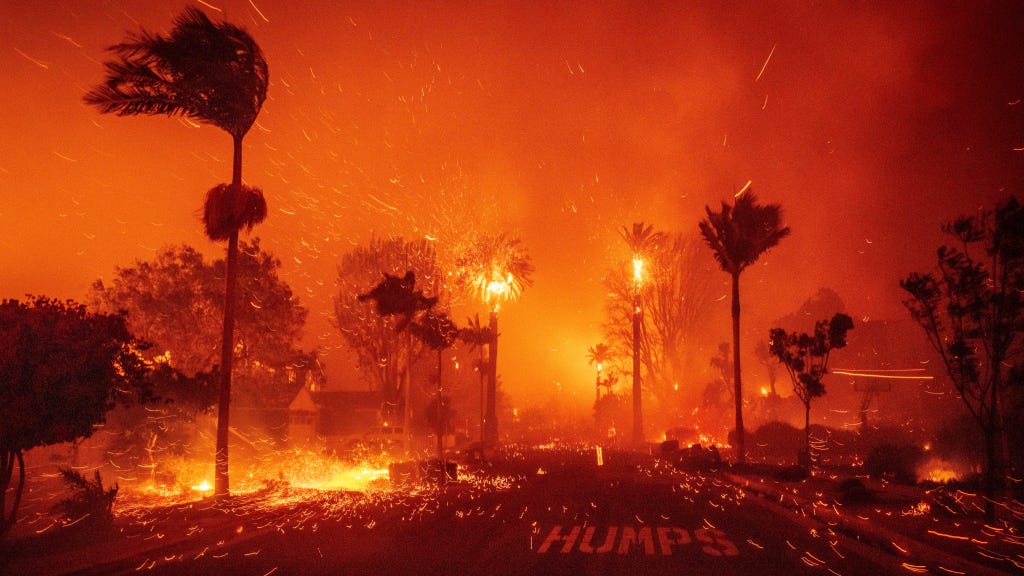The Swedish basketball coach, Andreas Forslund, residing in Santa Monica, California, finds himself facing the imminent threat of evacuation as a rapidly spreading wildfire encroaches upon his neighborhood. His words, ”We are probably next,” paint a stark picture of the anxiety and uncertainty gripping the community as flames relentlessly consume the dry landscape surrounding his home. The situation underscores the precariousness of life in areas prone to wildfires, especially amidst increasingly frequent and intense fire seasons exacerbated by climate change. Forslund’s story echoes the experiences of countless residents forced to confront the devastating power of nature and the potential loss of their homes and livelihoods. The situation is fluid and rapidly evolving, leaving residents like Forslund on high alert, constantly monitoring the fire’s progress and bracing for the possibility of an immediate evacuation order.
The fire, fueled by dry vegetation, strong winds, and record-high temperatures, is rapidly transforming the picturesque landscape into a scene of destruction. The inferno’s relentless advance has forced mandatory evacuations in neighboring communities, displacing thousands of residents and leaving a trail of charred remains in its wake. Firefighters are battling tirelessly against the flames, working around the clock to contain the blaze and protect properties, but the fire’s unpredictable nature and the challenging terrain are making containment efforts exceptionally difficult. The intense heat and smoke generated by the fire are creating hazardous air quality conditions, further compounding the challenges faced by both residents and emergency responders. The unsettling glow of the fire paints the night sky, a constant reminder of the imminent danger and the ongoing struggle to control the conflagration.
Forslund’s predicament highlights the increasing vulnerability of communities located in the wildland-urban interface, where residential areas abut wildlands. These areas are particularly susceptible to wildfires, as the proximity of homes to flammable vegetation creates a high-risk environment. The increasing frequency and intensity of wildfires, driven by climate change and prolonged periods of drought, necessitate a critical examination of urban planning and development strategies in these vulnerable zones. Implementing preventative measures, such as creating defensible space around homes and adhering to strict building codes, can significantly reduce the risk of wildfire damage. Furthermore, proactive forest management practices, including controlled burns and vegetation thinning, are crucial for mitigating the severity of wildfires.
As Forslund anxiously awaits updates on the fire’s trajectory, he, like many others, is faced with the daunting task of preparing for a potential evacuation. Gathering essential documents, medications, and cherished belongings becomes a priority, a stark reminder of the disruption and uncertainty that wildfires bring. The emotional toll of facing such a threat is immense, as residents grapple with the fear of losing their homes, the disruption to their lives, and the uncertainty of what the future holds. The sense of community, however, often shines through during such crises, as neighbors help one another prepare and offer support during these trying times.
The situation unfolding in Santa Monica serves as a microcosm of the larger issue of wildfire preparedness and mitigation. As climate change continues to exacerbate wildfire conditions, communities must prioritize proactive measures to mitigate risks and enhance resilience. Investing in advanced fire detection and suppression technologies, strengthening community wildfire protection plans, and educating residents about wildfire safety are critical steps in mitigating the devastating impacts of these events. Furthermore, promoting responsible land management practices and reducing greenhouse gas emissions are essential for addressing the root causes of increasingly frequent and intense wildfires.
Ultimately, Forslund’s story underscores the need for a comprehensive and proactive approach to wildfire management. This includes not only bolstering firefighting capabilities but also addressing the underlying factors that contribute to wildfire risk, such as climate change and land use practices. By acknowledging the interconnectedness of these factors and prioritizing community-based solutions, we can strive to create more resilient communities and safeguard lives and livelihoods in the face of the growing threat of wildfires. The ongoing fire in Santa Monica serves as a stark reminder of the urgency of this issue and the importance of collective action to mitigate the devastating impacts of wildfires in the future.














